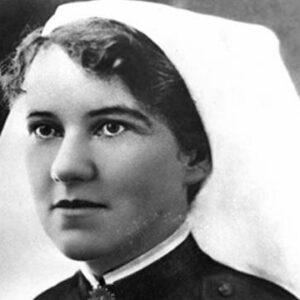Elizabeth Kenny was an Australian nurse and health administrator who, contrary to popular belief, advised treating poliomyelitis-affected muscles with moist hot compresses and exercises rather than immobilizing them with splints. After much research, she came to the conclusion that the tight muscles needed to be eased in order to lessen the disease’s effect. The treatments she used to revitalize the muscles became the foundation of physical therapy, which was eventually renamed modern physiotherapy. Despite the fact that her approaches were at variance with the mainstream medical concept of treating polio, she persevered and was able to effectively treat over 3000 individuals in Australia alone. Hundreds of other people were treated using her methods all around the world. Her methods astonished many doctors throughout the world, despite the fact that she had no professional medical degree or nursing background. She was the first woman to dethrone Eleanor Roosevelt from the top spot in the ‘Gallup Polls’ in a ten-year period. In 1946, a film called “Sister Kenny” was released that depicts her life story, her trials, and her eventual accomplishments.
Childhood and Adolescence
Elizabeth Kenny was born in Warialda, New South Wales, Australia, on September 20, 1880. Michael Kenny, an Irish farmer who had settled in Australia, and Mary Moore, an Australian native, were her parents.
Before she could attend schools in New South Wales and Queensland, she was schooled at home by her mother.
She became interested in anatomy when she was 17 years old and was being treated by Dr. Aeneas Mcdonnell in Toowoomba for a fractured wrist.
Career
Elizabeth Kenny worked as a bush nurse in the Clifton neighborhood from the age of 18 to her mid-twenties.
In 1907, she returned to Guyra, New South Wales, for rudimentary nursing instruction from a midwife.
During her time in Guyra, she worked as a broker for agricultural products between farmers and Brisbane markets.
In 1909, she returned to Nobby and began working as a qualified nurse despite her lack of credentials.
With the money she made from her brokerage business in Guyra, she founded the ‘St. Canice’s Hospital’ in Clifton in 1911.
She began treating patients by using hot compresses and weights to release their muscles, following Dr. McDonnell’s suggestion.
She volunteered as a nurse and sailed on the ‘Dark Ships,’ which transported wounded soldiers and traded goods from England to Australia during WWI.
For her work during the war, she was given the honorary title of ‘Sister’ in 1917, which was equivalent to the rank of ‘First Lieutenant’ in the ‘Australian Army Nurse Corps.’
She worked as a ‘Matron’ in Brisbane’s ‘Enoggera Military Hospital’ for a few weeks before being honorably discharged in 1919 owing to illness.
She constructed a makeshift hospital in Nobby in 1919 to care for patients during the influenza outbreak.
When she was diagnosed with the disease, she had to travel to Europe for treatment.
She returned to Nobby and cared for her friend’s cerebral diplegic kid, as well as other patients who were brought to her.
She once constructed a makeshift stretcher out of a cupboard door and drove her friend’s daughter, Sylvia, over 26 kilometers to Dr. McDonnell’s chamber in Toowoomba for treatment.
She improved the stretcher in 1927 and profitably sold the ‘Sylvia Stretcher’ throughout Europe, Australia, and the United States.
She nursed a crippled girl named Maude from Townsville in 1929 and was successful in making her walk in 18 months using her own tactics to treat the condition.
In 1932, behind the Queen’s Hotel in Townsville, Kenny established a makeshift polio treatment camp.
In 1934, the Queensland Health Department undertook the first evaluation of Kenny’s work, which resulted in the establishment of numerous polio clinics around Australia.
Despite doctors’ objections, she began treating an acutely ill patient in her George Street clinic. Later, in the Brisbane General Hospital’s Polio Clinic in Ward 7, the patient recovered entirely.
From 1935 to 1940, she traveled extensively throughout Australia and made two journeys to England to establish clinics.
The ‘Queensland Government Royal Commission’ published a report in 1938 criticizing Kenny’s methods of treatment. The Queensland government, on the other hand, dismissed the study and continued to support Kenny and her clinics.
Kenny and her adopted daughter Mary traveled to Minneapolis, Minnesota, in 1940 to show American doctors her procedures.
She established a clinic in Minneapolis in 1942. In 1951, she returned to Toowoomba.
Major Projects
Elizabeth Kenny’s first book, ‘The Treatment of Infantile Paralysis in the Acute Stage,’ was released in 1937.
Dr. John Pohl and she co-authored ‘The Kenny Concept of Infantile Paralysis and its Treatment,’ which was published in 1943.
In 1955, her book ‘My Battle and Victory: History of the Discovery of Poliomyelitis as a Systemic Disease’ was released after her death.
Achievements & Awards
‘Rutgers University’ and ‘University of Rochester’ awarded her honorary degrees.
In 1951, she was named the’most admired woman’ in a poll conducted by ‘Gallup Polls.’
Personal History and Legacy
Mary Stewart, one of her adopted daughters, went on to become one of her top researchers.
Elizabeth Kenny died on November 30, 1952, in Toowoomba, Queens, Australia, from Parkinson’s disease.
In Townsville, the ‘Sister Kenny Memorial and Children’s Playground’ was established in her honor.
Work in the Humanitarian Sector
Elizabeth Kenny spent her entire life caring for patients suffering from ailments such as meningitis, polio, and cerebral diplegia.
Elizabeth Kenny Net Worth
Elizabeth is one of the wealthiest psychologists and one of the most well-known psychologists. Elizabeth Kenny’s net worth is estimated to be $1.5 million, according to Wikipedia, Forbes, and Business Insider.


